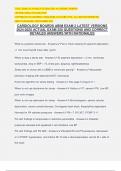TITLE: EMILLYCHARLOTTE 2024/2025 ACADEMIC PERIOD
OWNER: EMILLYCHARLOTTE
COPYRIGHT STATEMENT: ©2024 EMILLYCHARLOTTE. ALL RIGHTS RESERVED
FIRST PUBLISHED: SEPTEMBER 2024
CARDIOLOGY BOARDS ABIM EXAM 2 LATEST VERSIONS
2024-2025 ACTUAL EXAM 250 QUESTIONS AND CORRECT
DETAILED ANSWERS WITH RATIONALES
What is a positive stress test - Answer✔️✔️-Flat or Down sloping St-segment depression
>1 mm occurring 80 msec after j point
When to stop a stress test - Answer✔️✔️-St segment depression > 2 mm, ventricular
tachycardia, drop in SBP > 15, chest pain, dyspnea, lightheadedness
Stress test of choice with a LBBB or ventricular pacing? - Answer✔️✔️-Myocardial
perfusion imaging with adenosine,NOT exercising!
Know the algorithm for stress testing - Answer✔️✔️-See page 5-3,figure 5-1
When to not use doutamine for stress - Answer✔️✔️-History of VT, severe HTN, Low BP,
poor echo images
When to not use adenosine for stress - Answer✔️✔️-Bronchospasm, severe valvular
dysfunction, severe carotid stenosis, 2nd degree heart block, theophylline dependent
Normals for PA catheter pressures - Answer✔️✔️-RA <7, RV 30/7, PCWP 3-11
PA cath findings in tamponade or restrictive pericarditis - Answer✔️✔️-Diastolic
pressures elevated and equalized in all chambers, low BP
PA cath findings with RV AMI - Answer✔️✔️-Elevated RA and PA pressures, decreased
or nl PCWP, hypotension, and inferior MI. R side is decompensated, cannot fill L side of
the heart
,TITLE: EMILLYCHARLOTTE 2024/2025 ACADEMIC PERIOD
OWNER: EMILLYCHARLOTTE
COPYRIGHT STATEMENT: ©2024 EMILLYCHARLOTTE. ALL RIGHTS RESERVED
FIRST PUBLISHED: SEPTEMBER 2024
PA cath findings in cardiogenic shock - Answer✔️✔️-Elevated PCWP, RA pressure, and
decreased SBP/cardiac output
PA cath findings in mitral stenosis with RV failure - Answer✔️✔️-Elevated RA, PA (very
elevated), PCWP, nl SBP
PA cath findings in pulmonary HTN - Answer✔️✔️-Elevated PA, RA pressures, nl PCWP,
SBP
Pulsus paradoxus - Answer✔️✔️-decrease in systolic BP of more than 10mmHg with
normal inspiration; palpated as weakened pulse with inspiration along with more heart
contractions to pulse beats
What conditions give you pulsus paradoxus? - Answer✔️✔️-Constrictive or restrictive
pericarditis, asthma, tension pneumothorax
What gives you pulsus bisferiens (two systolic peaks per cycle) - Answer✔️✔️-Aortic
regurgitation, HOCM
What causes pulsus alternans - Answer✔️✔️-Severe LV dysfunction
What causes pulsus tardus - Answer✔️✔️-Aortic stenosis
How do positional maneuvers affect blood flow and murmurs - Answer✔️✔️--
standing/valsalva - decreased cardiac filling, decreases most murmurs except MVP and
HOCM
-squatting/ lying down - increase cardiac volume, increased murmurs except MVP,
HOCM
,TITLE: EMILLYCHARLOTTE 2024/2025 ACADEMIC PERIOD
OWNER: EMILLYCHARLOTTE
COPYRIGHT STATEMENT: ©2024 EMILLYCHARLOTTE. ALL RIGHTS RESERVED
FIRST PUBLISHED: SEPTEMBER 2024
-sustained handgrip - increases systemic resistance, decreases murmur in HOCM, AS
What causes a physiologic split S2 - Answer✔️✔️-Increased blood volume in the RV
prolongs systole and delays pulmonary valve closure
What causes a fixed split S2 - Answer✔️✔️-Pulmonary stenosis, PE, LV pacer, RBBB,
MR (early AV closure), ASD, RV failue
What causes a paradoxic split S2 - Answer✔️✔️-LBBB, RV pacing, HOCM
What causes an S3? - Answer✔️✔️-Rapid LV filling - acute ventricular decompensation,
severe AR or MR
KNOW - S3 with LV dysfunction is a poor prognostic factor - Answer✔️✔️-...
What causes a S4? - Answer✔️✔️-Decreased ventricular compliance during atrial
contraction - ischemic heart dz, AS, MR, HOCM, hypertrophic or diabetic
cardiomyopathy, HTN heart dz, concentric LVH
Can you have a S4 with atrial fibrillation? - Answer✔️✔️-No - no atrial contraction
What are the parts of the venous waveform? - Answer✔️✔️-A wave - atrial contraction
X descent - atria relax, RV fills rapidly
Bottom of x descent is TC valve closure
V wave - ventricle contacting against closed TC valve
Y descent - TC valve opens, passive emptying into ventricle
What gives elevated a and v waves - Answer✔️✔️-Pulmonary HTN, RV infarction
Large r side v waves - Answer✔️✔️-Septal rupture
, TITLE: EMILLYCHARLOTTE 2024/2025 ACADEMIC PERIOD
OWNER: EMILLYCHARLOTTE
COPYRIGHT STATEMENT: ©2024 EMILLYCHARLOTTE. ALL RIGHTS RESERVED
FIRST PUBLISHED: SEPTEMBER 2024
Large v waves - Answer✔️✔️-TR (right), MR (left)
Rapid x and y descent - Answer✔️✔️-Constrictive pericarditis, restrictive cardiomyopathy,
tamponade (x descent only, loss of y descent)
Large a waves - Answer✔️✔️-TS,severe RVH (on right), MS
Cannon a waves - Answer✔️✔️-AV disassociation - complete heart block, ventricular
pacing
Slow Y descent - Answer✔️✔️-Delayed atrial emptying - TS
Most important prognostic factor with CAD - Answer✔️✔️-Degree of LV dysfunction
Causes of resting ST elevation - Answer✔️✔️-MI, pericarditis, LV aneurysm, LBBB,
ventricular pacing, LVH, early repolarization
Hibernating myocardium - Answer✔️✔️-myocardium near the infarction may be
underperfused but not necrotic-the metabolism of the cells adapts to low energy
supplies and are nonfunctional until perfusion is restored
Reperfusion injury - Answer✔️✔️-the re-establishment of blood flow after a coronary
artery is blocked, which may further damage the heart tissue due to the formation of
oxygen free radicals
Stunned myocardium - Answer✔️✔️-prolonged post ischemic dysfunction, salvaged by
reperfusion, several days




